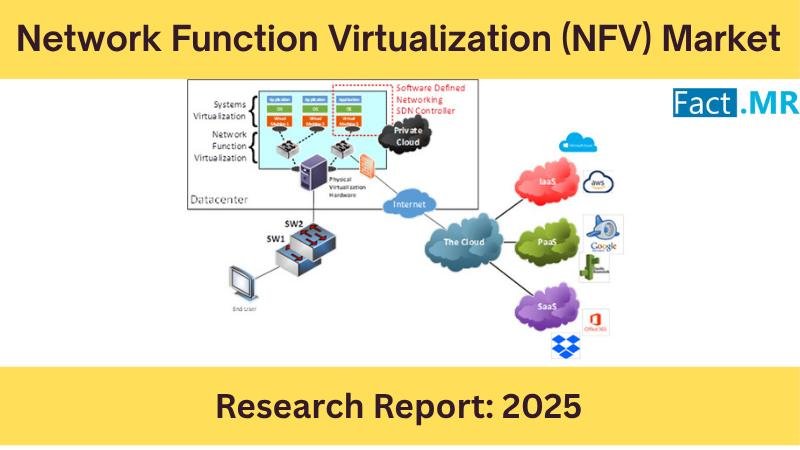The global Network Function Virtualization (NFV) Market is poised for steady growth, projected to rise from a valuation of $3.9 billion in 2021 to an estimated $7.8 billion by 2032, according to a detailed report by Fact.MR. This expansion, driven by a compound annual growth rate (CAGR) of 6.6%, reflects the increasing adoption of virtualized software solutions across enterprise data centers and the growing demand for scalable, cost-effective network infrastructure.
For More Insights into the Market, Request a Sample of this Report: https://www.factmr.com/connectus/sample?flag=S&rep_id=1327
Surging Demand for Virtualized Solutions Drives Market Growth
The rapid adoption of virtualized software among enterprise data centers, including Internet Service Providers (ISPs) and Cloud Service Providers (CSPs), is a key driver of the NFV market. NFV enables organizations to virtualize network services traditionally performed by proprietary hardware, such as routers, firewalls, and load balancers, thereby reducing operational costs and enhancing network agility. The report highlights that NFV’s ability to minimize hardware dependency and streamline network management is fueling its uptake across industries like banking, financial services, and insurance (BFSI), healthcare, retail, and IT.
The growing trend of cloud-based networking systems and the rising demand for data-intensive applications are creating significant opportunities for NFV adoption. Enterprises worldwide are leveraging NFV to handle increasing network traffic and data conflicts, particularly as small and medium enterprises (SMEs) embrace virtualization technologies for faster server provisioning and network service deployment. The report notes that NFV’s compatibility with Internet of Things (IoT) appliances and private cloud computing has further boosted its market potential, as demonstrated by successful testing in recent years.
Technological Advancements and 5G Transition Fuel Expansion
The shift toward 5G network services is a major catalyst for NFV market growth. Unlike traditional networking, 5G NFV architecture enables scalable delivery of network services, supporting diverse use cases such as enhanced mobile broadband, ultra-reliable low-latency communications, and massive IoT deployments. NFV facilitates network slicing, allowing operators to create virtual networks tailored to specific applications on a single physical infrastructure. This flexibility is critical for managing the dynamic configurations required by 5G networks, driving demand for NFV solutions among telecom operators.
The report also underscores the role of the NFV white paper, which outlines optimized scalability and agility for network control and performance upgrades. By integrating NFV with software-defined networking (SDN), organizations can achieve centralized network management and dynamic resource allocation, further enhancing operational efficiency. The commercial deployment of NFV by telecom carriers is paving the way for sustainable smart technologies, with significant investments in software applications outpacing traditional storage facilities.
Regional Insights: U.S. and China Lead, Europe Gains Traction
The United States is a dominant force in the NFV market, driven by its advanced telecom infrastructure, high adoption of cloud computing, and presence of leading technology providers. The U.S. market is expected to lead globally, supported by increasing investments in data center consolidation and server virtualization. The report highlights that the accelerated adoption of cloud computing services among both large enterprises and SMEs is a key growth factor in the region.
China is witnessing rapid NFV adoption, fueled by its expanding 5G infrastructure and growing demand for virtualized network services. The country’s focus on digital transformation and smart city initiatives is driving investments in NFV, particularly in the telecom and IT sectors. The report projects strong growth in China, supported by government-backed efforts to modernize network infrastructure.
Europe, particularly countries like Germany, France, and the United Kingdom, is also a significant market, with increasing demand for NFV driven by the rollout of 5G networks and the need for cost-effective network management solutions. The region’s emphasis on open NFV ecosystems and collaborative alliances is enhancing market competitiveness.
Market Segmentation and Key Trends
The Fact.MR report segments the NFV market by component, application, end user, and region:
By Component: Software holds the largest market share, driven by the shift from hardware-based to software-defined network functions. Hardware and services also contribute significantly, with services including system integration and consulting gaining traction.
By Application: Applications in telecom, IT, BFSI, healthcare, retail, and manufacturing are key growth areas. The telecom sector leads due to the widespread adoption of NFV for 5G and network slicing.
By End User: Enterprises, cloud service providers, and telecom operators are major adopters, with enterprises benefiting from reduced hardware costs and improved network scalability.
By Region: North America, Europe, Asia Pacific, Latin America, and the Middle East & Africa, with North America and Asia Pacific as high-growth regions.
Key trends shaping the market include:
Data Center Consolidation: Enterprises are consolidating data centers to optimize resources, driving demand for NFV solutions that enhance server virtualization.
5G Deployment: The transition to 5G necessitates NFV for managing complex network architectures and supporting network slicing.
Open NFV Ecosystems: Collaborative platforms like open NFV are fostering innovation and enabling market players to differentiate their offerings.
Cloud-Based Networking: The growing adoption of cloud services is creating opportunities for NFV to support scalable and flexible network infrastructures.
Challenges and Opportunities
The NFV market faces challenges, including delays in adoption by some potential customers due to concerns over integration complexities and security risks associated with virtualized networks. The need for skilled professionals to manage NFV deployments also poses a barrier, particularly for smaller organizations. Additionally, the high initial investment required for transitioning to virtualized infrastructure can deter adoption in cost-sensitive markets.
However, these challenges are offset by significant growth opportunities. The increasing demand for cost-effective network solutions and the proliferation of IoT devices are driving NFV adoption across industries. The report highlights that forming strategic alliances and leveraging open NFV communities will enable market players to strengthen their positions and generate revenue. The growing trend of cloud-native architectures and automation in networking further presents lucrative prospects for NFV providers.
Competitive Landscape and Strategic Developments
The NFV market is highly competitive, with key players focusing on product innovation, partnerships, and global expansion. Leading companies are differentiating their services through unique value propositions, such as enhanced scalability and integration with emerging technologies like AI and machine learning. The report emphasizes that forging strong alliances and participating in open NFV ecosystems will be critical for market success.
Notable developments include increased investments in R&D to develop advanced NFV solutions tailored for 5G and IoT applications. The report surveyed industry stakeholders, including telecom operators, cloud service providers, and enterprise IT managers, to provide a comprehensive analysis of market dynamics and competitive strategies.
Browse Full Report: https://www.factmr.com/report/1327/nfv-market
Future Outlook
The Network Function Virtualization market is set for sustained growth through 2032, driven by the global transition to 5G, the rise of cloud-based networking, and the increasing need for scalable network infrastructure. The integration of NFV with emerging technologies like AI-driven network management and edge computing is expected to further enhance market potential. With an absolute dollar opportunity of $3.9 billion over the forecast period, the NFV market represents a transformative segment in the telecommunications and IT industries, offering cost-effective and agile solutions for the digital era.
Check out More Related Studies Published by Fact.MR:
Network Access Control Market: https://www.factmr.com/report/4061/network-access-control-market
Network Analyzer Market: https://www.factmr.com/report/network-analyzer-market
Network Attached Storage (NAS) Market: https://www.factmr.com/report/network-attached-storage-nas-market
Network Performance Monitoring Market: https://www.factmr.com/report/network-performance-monitoring-market
Contact:
US Sales Office
11140 Rockville Pike
Suite 400
Rockville, MD 20852
United States
Tel: +1 (628) 251-1583, +353-1-4434-232
Email: sales@factmr.com
About Fact.MR
We are a trusted research partner of 80% of fortune 1000 companies across the globe. We are consistently growing in the field of market research with more than 1000 reports published every year. The dedicated team of 400-plus analysts and consultants is committed to achieving the utmost level of our client’s satisfaction.
This release was published on openPR.

















